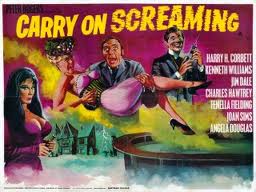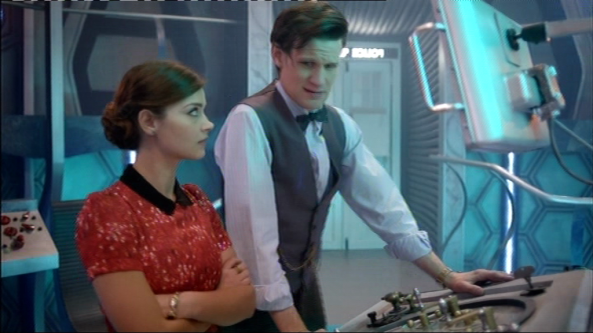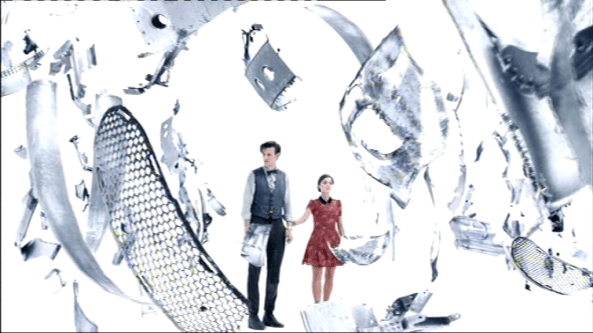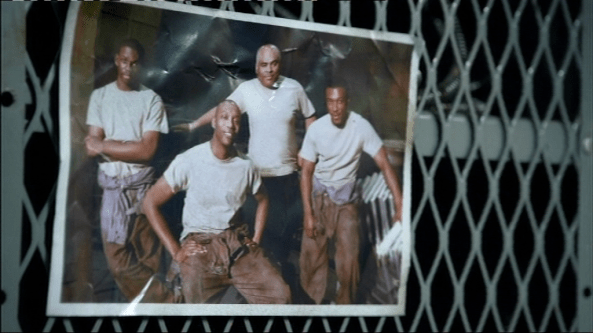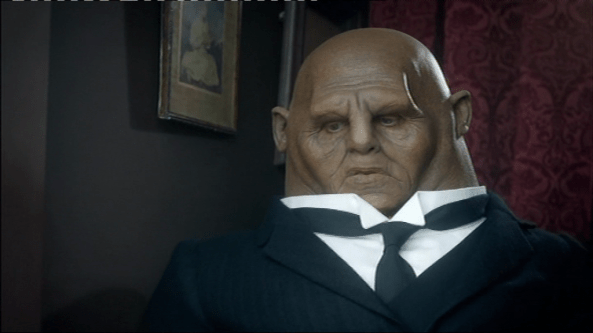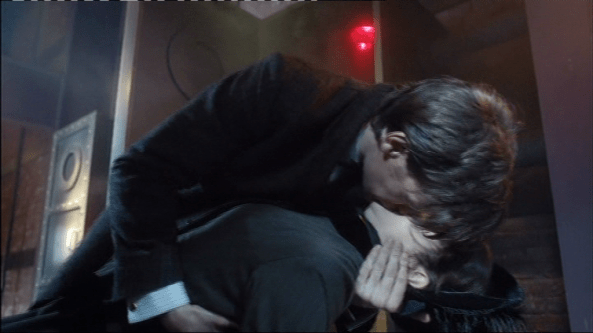Philip Jose Farmer is to be applauded for many great auctorial achievements, one of the jauntiest being his Wold Newton sequence of books.
Introduced in the 1972 novel Tarzan Alive, Farmer’s core idea is that a meteorite falling in Wold Newton, Yorkshire in 1795 irradiated a coachful of passing travellers. The descendants of these travellers were, as a result, uniquely endowed and included Tarzan, Sherlock Holmes, Doc Savage, Peter Wimsey, Phileas Fogg, Allan Quatermain, Raffles, Bulldog Drummond, Richard Hannay, Professor Challenger, Sam Spade, Philip Marlowe, James Bond, Travis McGee and many others.
It prefigures and has clearly influenced Kim Newman’s spirited Anno Dracula series as well as Alan Moore’s cussed, helical League Of Extraordinary Gentlemen comic book.
Farmer also created Riverworld. I pretty much love him.
A similar catalysis to the one provided by the Wold Newton meteorite is observable in the real world in a legendary 1974 Halloween TV screening of Carry On Screaming.
It seems that every curious and morbidly inclined person of my approximate age saw it (including, independently, all four members of The League Of Gentlemen), and it sent a nerdy generation of us, already under the influence of Doctor Who, off on a search which would lead us to discover Hammer films, Quatermass, the Universal monster movies, The Wicker Man, Witchfinder General, Blood On Satan’s Claw, Arthur Conan Doyle, Jules Verne, Edgar Rice Burroughs and so forth.
The fallout of that single showing of Carry On Screaming, I remain convinced, influenced the direction of British genre broadcasting way more than Star Wars ever did. And this clutch of Doctor Who episodes bears witness to that pretty spectacularly.
Journey To The Centre Of The TARDIS opens like a private sector version of Aliens, but rapidly shrugs off this hard SF carapace in favour of a late Victorian/early Edwardian phantasmagoria in the idiom of H.G. Wells or (as alluded to in the episode title) Jules Verne.
There is a lot to love in Journey: the repartee between Clara and the Doctor (once they are reunited); the sinister lighting schemes and skewed camera angles; the defocused, agonised monsters which reminded me so much of the discorporating Eddie Jessup in Altered States willing himself back into existence. But, incidental pleasures aside, Journey To the Heart Of The TARDIS is by an order of magnitude the weakest episode of the series so far.
(As a side note, Altered States is a key movie of the eighties, often overlooked. If you haven’t seen it you absolutely must. Or we can’t be friends any more.)
Writer Steve Thompson, as with his earlier endeavour The Curse Of The Black Spot (2011), fails to distinguish his supporting characters sufficiently. The Van Baalen brothers’ motivation is all over the place, their dialogue is awful, and I do not buy for one microsecond all that stuff about Tricky thinking he is an android. It simply doesn’t work.
The overuse of self-actuating, circular plot devices is a bit of an eye-roller too. It is sort of clever that the monsters are Clara and the Van Baalen brothers, and that the act of escaping from the monsters causes their creation. But to couch that twist in a story whose denouement involves interfering with the past so that events never happen is really pretty feeble.
It’s a shocking cop-out that ending. One that makes you wonder why there have been any stories at all over the last fifty years, if that’s really an option: going back to the beginning and preventing the narrative’s inciting incident. And to then stick on some half-hearted attempt to suggest that the Van Baalen brothers have somehow become nicer as a result of the events that NEVER HAPPENED is really taking the fucking biscuit.
Journey reportedly came about as a result of Steven Moffat’s dissatisfaction at earlier explorations of the TARDIS, specifically in the closing episodes of The Invasion Of Time (1978). Now, leaving aside the fact that I love the dank, municipal aspect of the bits of the TARDIS we see in that story, it is still not always a good idea to concretise things we have been imagining for so long.
As an object of infinite potential the interior of the TARDIS was a very beguiling environment. Its reification was inevitably disappointing. This making explicit of that which has previously been alluded to is really fan fiction territory. It would have to be pretty damn special to work in the context of the programme and this, sadly, isn’t.
A happy aspect of the episode is that it does at least carry on the season’s motif of referencing specific classic Doctors, the Fourth in this instance. Beyond the simple giggle at the TARDIS pool, the whole thing is reminiscent of an unproduced Fourth Doctor story called The Enemy Within. Written by esteemed novelist Christopher Priest (himself highly influenced by H.G. Wells) this was to have revealed the source of the TARDIS’s power as an octopus-like creature living off fear.
That would have been better.
Carry On Screaming exerts a much more direct influence on the next episode, the vastly superior The Crimson Horror written by Mark Gatiss.
He is one of the writers most closely attuned to Doctor Who is Gatiss. Several exemplary Who stories aside, he has also been involved with The League Of Gentlemen (whose influences are manifold), Crooked House (a scary Tigon/Amicus-style compilation), The First Men In The Moon, Catterick, Funland, the remake of The Quatermass Experiment, Dr. Terrible’s House Of Horrible and Sherlock. That’s an unimpeachable oeuvre. (We will leave his appearance in Sex Lives Of the Potato Men to one side as I have not seen it. Perhaps it’s good.)
He brings all these influences to bear in The Crimson Horror but especially one I have not seen him reference before: his beloved James Bond. Because what is The Crimson Horror if it is not a steampunk Moonraker? And Moonraker itself is triple distilled Bond being a straight re-write of The Spy Who Loved Me which was itself a version of You Only Live Twice.
Do pay attention, 007.
And there was so much more.
The fainting Mr. Thursday (the name possibly a G.K. Chesterton wink) seems to be a specific reference to Peter Butterworth’s Carry On Screaming character, Constable Slobotham.
The optogram business, which I adored, is straight out of Eugenio Martin’s perfunctory but awesome film Horror Express.
Jenny’s leather catsuit seemed particularly provocative in the presence of Diana Rigg. “Mrs. Peel. We’re needed!” And how great was it to finally hear Diana Rigg acting in her native Doncaster accent? Bloody great, that’s how great.
What tickled me most though, as a lad from Leeds with a lust for life, was to see Mark Gatiss getting stuck into a proper Yorkshire Doctor Who story. I loved the idea that Mr. Sweet is the antithesis of the real world’s Mr. Salt: Titus Salt who used his textile wealth to establish Saltaire, a model village designed to reduce pollution in Bradford and to deliver his workers from the slums. A lovely, clever touch.
The only things I was slightly unsure about were Matt and Jenna-Louise’s accents which sounded less Yorkshire to me, and more Victoria Wood comedy-Lancashire. This may have been deliberate. They were very, very funny.
Also I didn’t quite get Clara’s mystification at the pictures of her in Victorian London. Surely she would have thought, well I haven’t been there yet but, you know, blah blah blah time machine blah blah blah. Anyway, no matter. It was a brilliantly chilling scene rounding off a masterful episode.
Nice Fifth Doctor touches included the heavy roster of companions and a loving description of Tegan.
Next time, Neil Gaiman’s Cybermen.









